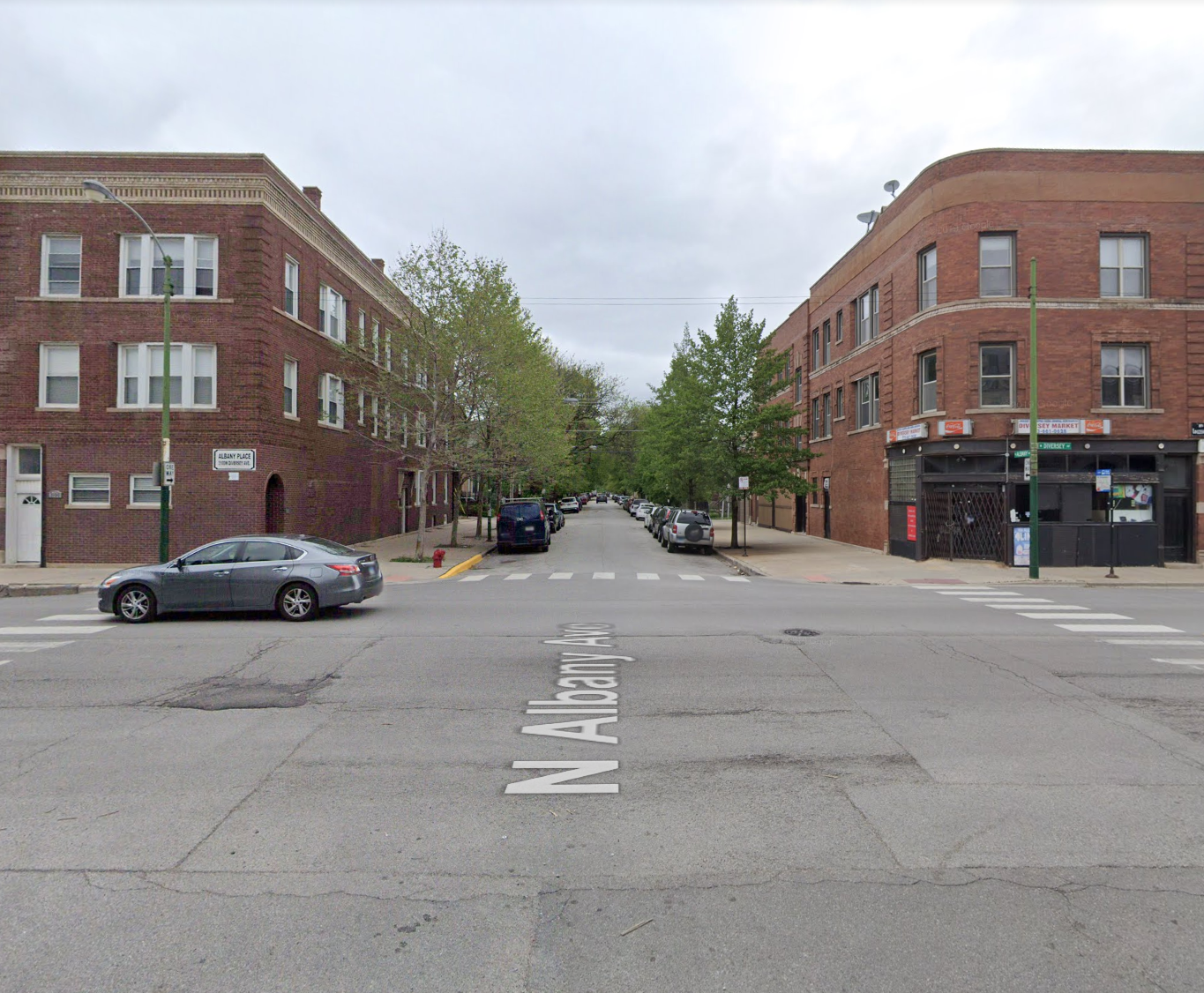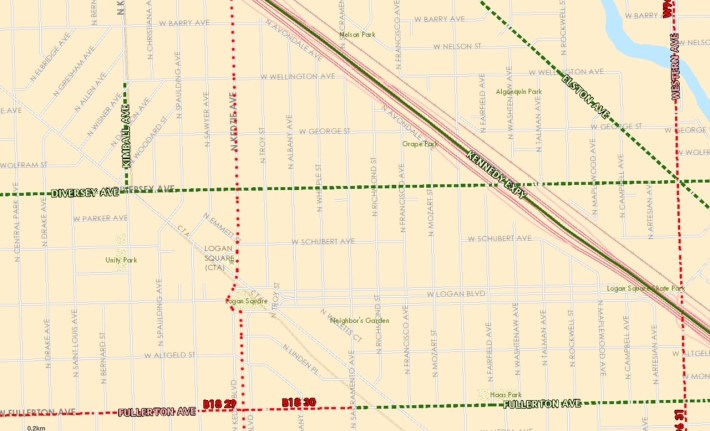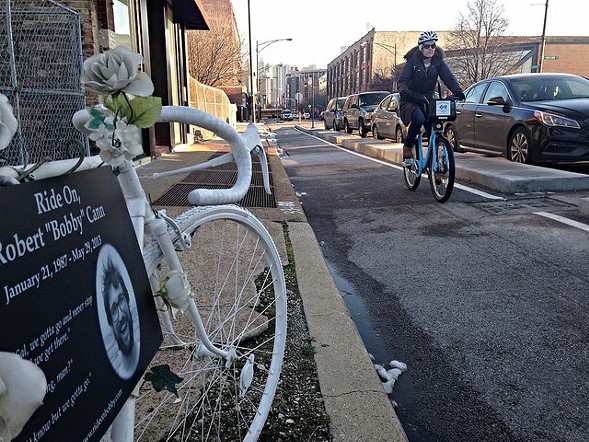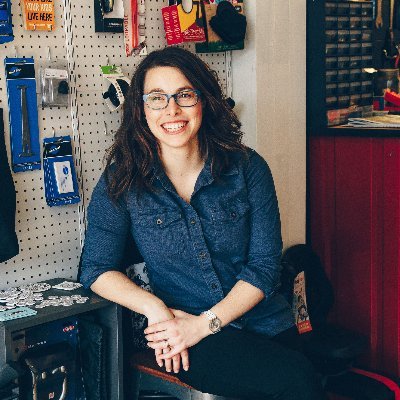Logan pedestrian fatality highlights how IDOT control of Chicago streets makes us less safe
6:57 PM CDT on April 13, 2021

The intersection of Diversey and Albany, looking north, as it appeared in May 2019. The crosswalks have reportedly faded since then. Image: Google Maps
A horrifying incident where a driver struck and dragged a man in Logan Square has laid bare how the Illinois Department of Transportation having final say on changes to many Chicago streets makes our city more dangerous.
According to the Chicago Police Department, on Sunday, April 11, at 3:25 p.m., a man was lying in the street at Diversey and Albany avenues when a motorist driving west on Diversey made a right turn to head north on Albany and struck and dragged the man. The victim was taken to Illinois Masonic Hospital in critical condition. As of this evening, CPD had no updates on citations or charges for the driver.
Four Star Family Cyclery owner Elsbeth Cool was working at the shop, located at the southwest corner of the intersection, when the crash occurred, and she called 911. In a letter to local aldermen Rossana Rodriguez-Sanchez (33rd) and Scott Waguespack (32nd) she sent in the wake of the incident, she described what she saw.
Cool wrote that she was preparing to leave work when she noticed the man lying in the north crosswalk of Diversey/Albany. "The cause of the fall was unclear, but I did not see him moving." She said the westbound driver, a woman, "rapidly slowed" before making a sharp right due to a large Jeep parked on the northeast corner of the intersection in part of the crosswalk, partially blocking the driver’s view of the crosswalk and the man lying in the street."
After running over the victim, Cool wrote, "not even realizing what had happened, she continued driving several hundred yards northbound on Albany [a one-way northbound street], dragging the man along under the car. This all happened in my full view, as well as at least two other witnesses." She said the driver, who stayed at the scene after she stopped, "sobbed in anguish and horror at what she had just done."
Cool noted that the intersection is home to two daycare centers, a few large apartment buildings, two bus stops, a large laundromat, and the restaurant Superkhana International. "There is a high volume of foot traffic at all hours of the day and into the evening." She wrote that the crosswalks are faded and drivers often fail to stop for pedestrians in them. There are traffic signals a block west at Kedzie Avenue and a block east at Sacramento Avenue, and she said drivers often speed between them, attempting to catch a light before it turns red.
"I cross at this intersection multiple times a day (often with my children)," Cool wrote. "In the 13 years I have lived [in Chicago], I’ve lost count of the times we have nearly been mowed down by drivers ignoring the crosswalk and regularly wait on the sidewalk for 2-3 minutes just waiting for an opening in traffic in order to safely pass across the street."
Cool moved her shop to the intersection about a year ago, and she said she's often thought the location would be safer if stop signs were installed on Diversey, which would discourage drivers from racing between the two stoplights. As it stands, only northbound drivers on Albany approaching Diversey have a stop sign. "My great regret is that it took witnessing one of my neighbors being run over by another neighbor to sit down and formally request traffic calming measures be installed at this intersection. Shame on me for not taking action sooner."
She asked Rodriguez-Sanchez and Waguespack for their help getting the stop signs installed at the intersection, which is located on the border of their wards. "With an intersection that required a reduction of speed and more careful navigation from drivers, this tragic and traumatizing event might have been avoided. A four-way stop seems an excellent and easy solution... especially [given] the many families and elderly neighbors we see every day attempting to use the crosswalks." Cool launched a petition for the stop signs which has garnered more than 680 signatures.
According to the city's crash data portal, a driver struck a pedestrian at this site a little over a year ago on February 12, 2020.
Paul Sajovec, Waguespack’s chief of staff, told Block Club Chicago's Mina Bloom that the ward has asked the Chicago Department of Transportation to conduct a traffic study at the site. However, Sajovec later said that CDOT told his office that stop signs are a non-starter because that segment of Diversey is an arterial street under IDOT jurisdiction, and the signs would be contrary to state guidelines. Diversey between Central Park and California avenues is slated to be repaved with buffered bike lanes and sidewalk bump-outs. The 32nd Ward office has not heard any feedback from residents about the intersection before Sunday's crash, Sajovec told Block Club.

"This is not how you plan for transportation safety, though," responded Streetsblog Chicago cofounder Steven Vance. He argued that not putting stop signs at an intersection where pedestrians currently resign themselves to playing Frogger with drivers is similar to not building a bridge across a river because some people are able to swim across it.
"What's the point of state highways in/through cities?" tweeted landscape architect Kris Lucius in response to the news. "They rarely function differently than comparably sized city streets. Nobody takes Irving Park or North instead of Fullerton because it has a number... If I were a city I'd want to own my roads."

IDOT's control of Chicago streets has been a recurring barrier to safer streets. For years the department quietly blocked the installation of protected bike lanes on state roads within the city, although the May 2013 killing of cyclist Bobby Cann by a drunk, speeding driver on Clybourn Avenue in River North, a state route, spurred the end of that harmful policy.
But state jurisdiction of Chicago streets continues to be a major hurdle for CDOT proposals to install bikeways, implement road diets, and other safety initiatives, because IDOT has long prioritized moving car traffic quickly through the communities we walk and bike in. Abolishing it would go a long way towards making our streets safer.
Sign the petition to install stop signs at Diversey/Albany here.
Fatality Tracker: 2021 Chicago pedestrian and bicyclist deaths on surface streets
Pedestrian: 8
Bicyclist: 1
Note: Streetsblog Chicago’s traffic death numbers represent fatal crashes on Chicago surface streets, based on media reports and/or preliminary Chicago Police Department data released by the Chicago Department of Transportation.
In addition to editing Streetsblog Chicago, John writes about transportation and other topics for additional local publications. A Chicagoan since 1989, he enjoys exploring the city on foot, bike, bus, and 'L' train.
Stay in touch
Sign up for our free newsletter
More from Streetsblog Chicago
They can drive 25: Residents, panelist support lowering Chicago’s default speed limit
While there's no ordinance yet, the next steps are to draft one, take a committee vote and, if it passes, put it before the full City Council.
One agency to rule them all: Advocates are cautiously optimistic about proposed bill to combine the 4 Chicago area transit bureaus
The Active Transportation Alliance, Commuters Take Action, and Equiticity weigh in on the proposed legislation.




